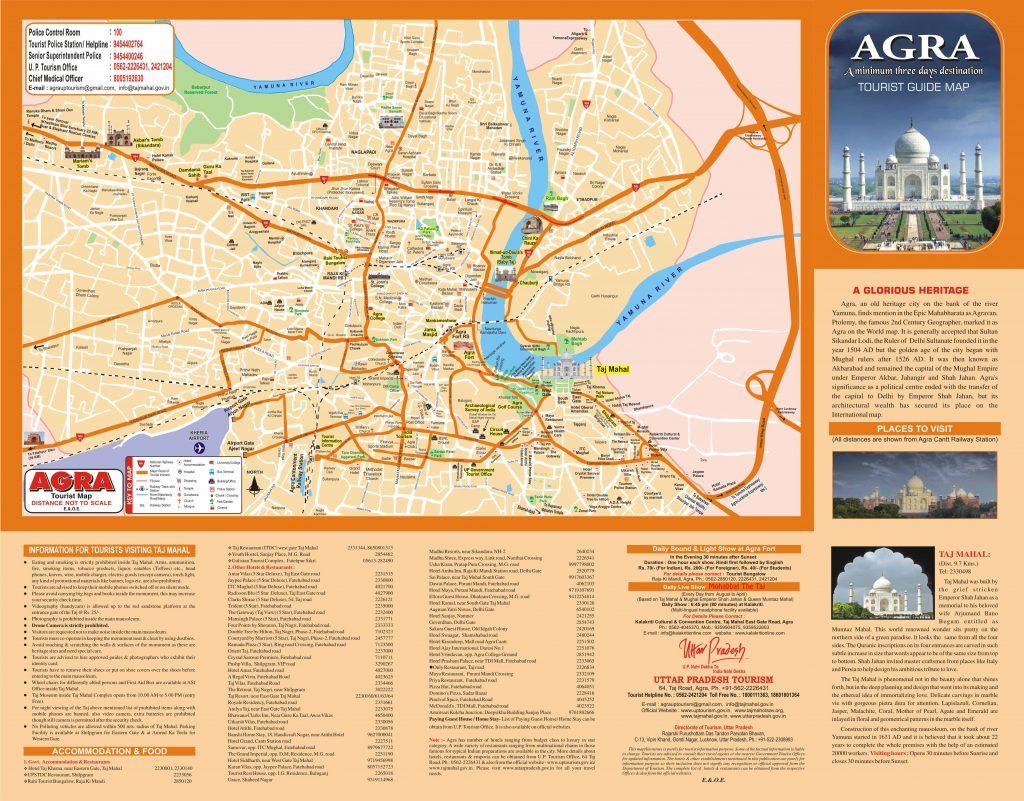Opens 30 Minutes before sunrise and closes 30 Minutes before sunset. Closed on Fridays
Agra is home to the Taj Mahal, one of the seven Wonders of the World and is one of the most popular tourist destinations in India. Needless to say, it features on the itinerary of not just domestic tourists but also foreign travellers. Agra is situated in the north Indian state of Uttar Pradesh and along with Jaipur and Delhi forms the Golden Triangle of Indian tourism.
Believed to have been built in 1475, Agra even finds a mention in the epic Mahabharatha where it is called Agraban (meaning paradise). The renowned second century geographer Ptolemy had also spotted this place as Agra in his world map. The present Agra city was established by Sikandar Lodi of the Lodi Dynasty in the 16th century and was the capital of the Lodi and Mughal dynasties.
The examples of art and culture in this historic city are not only breathtaking, but are also mirrors of the artistic talents of the Indian population during the grand past. The city houses many ancient temples, mosques, forts, mausoleums, tombs and historical monuments. The city has its unique style of traditional paintings, folk dances, folk music and embroideries.
Aside from the Taj Mahal, Agra has two other UNESCO World Heritage Sites: Agra Fort and Fatehpur Sikri. Taj Mahal in the night is a sight to behold but entry is restricted.
BEST TIME TO VISIT AGRA
The average minimum and maximum temperature of Agra is as given below. The best time to visit Agra is also specified.
| MONTH | BEST TIME | MIN. TEMP (°C) | MAX. TEMP (°C) |
| January | √ | 7 | 20 |
| February | √ | 9 | 24 |
| March | √ | 13 | 29 |
| April | 19 | 34 | |
| May | 23 | 37 | |
| June | 25 | 36 | |
| July | 24 | 32 | |
| August | 23 | 30 | |
| September | 22 | 33 | |
| October | √ | 16 | 32 |
| November | √ | 11 | 27 |
| December | √ | 7 | 23 |

Taj Mahal

“The embodiment of all things pure”, said Rudyard Kipling on Taj Mahal’s beauty and that is no wordplay as the Taj is undoubtedly a pure epitome of beauty. It is an immortal poem in white marble and is the finest expression of love of an emperor for his queen. Located on a bank of River Yamuna, it was built by Mughal Emperor Shah Jahan in memory of his beloved wife and Queen Mumtaz Mahal in 1631, who died giving birth to his child and whose last wish to her husband was “to build such a tomb in her memory which the world has never seen before.” It took over 17 years, 22000 workers and 1000 elephants to build the wonderful mausoleum.
The Taj Mahal is one of the three World Heritage Sites in India. Set in a serene Mughal Garden the monument stands on a raised marble platform, with its back towards Yamuna River. The four sides of the Taj Mahal show a perfect symmetry and feature impressive vaulted arches embellished with Pietra Dura scrollwork, and verses from the Quran in calligraphy using inlaid jasper. This architectural masterpiece is one of the most frequented places in India by photographers and foreign tourists. The Taj Mahal looks as immaculate today as when it was first built, leaving the onlookers mesmerized.
Agra Fort
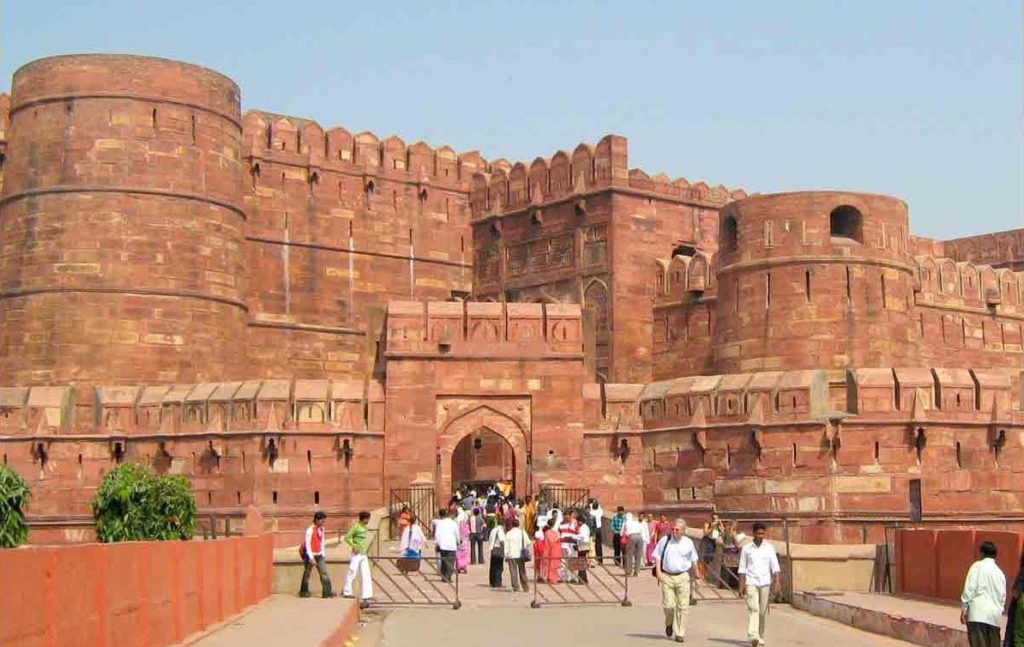
A massive red-sandstone fort located on the banks of River Yamuna was built under the commission of Emperor Akbar in 1565 and was further built by his grandson Shah Jahan. The fort, semi-circular on plan, is surrounded by a 21.4 m high fortification wall. The fort was built primarily as a military structure; parts of it are still reserved under Indian Army. Shah Jahan transformed it into a palace, later it became his gilded prison for eight years after his son Aurangzeb seized power in 1658. The fort houses a maze of buildings, including vast underground sections. The Amar Singh Gate to the south is the sole entry point. A path leads straight from here up to the large Moti Masjid. Just before this is the open Diwan-e-Aam, where Shah Jahan listened to people’s petitions or issues. A small staircase just to the left of Diwan-e-Aam throne leads up to a large courtyard. To the left is a beautiful white marble Nagina Masjid. Other places to see within the Fort are: Diwan-e-Khas - which once housed Shah Jahan’s legendary Peacock throne and the diamond Koh-I-Noor, Shish Mahal- a palace with walls inlaid with tiny mirrors, and Khas Mahal - the white octagonal tower and palace. In the South of the fort, there is a huge red-sandstone Jahangir’s Palace, built by Akbar probably for his son Jahangir.
Sikandra/Akbar’s Tomb
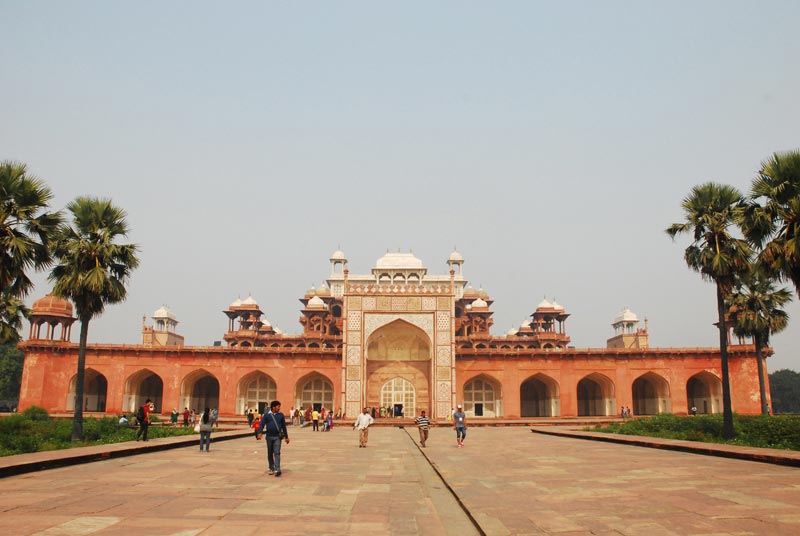
Located in the western periphery of the city, the red-sandstone and marble tomb was built by Emperor Akbar, which was later completed by his son Jahangir. Its interior is covered with exquisite calligraphy that reflects the tenets of Din-e-Ilahi, a religious movement started by Emperor Akbar based on the fusion of primarily Hinduism and Islam including other religions as well. Sikandra is the resting place of the Mughal emperor Akbar and his grave lies here in a dark chamber. The outlying garden which is laid out in the Char Bagh style is yet another attraction of the place.
Itmad-Ud-Daula
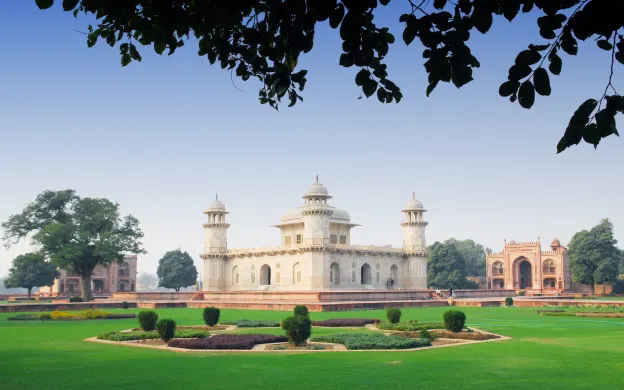
A masterpiece of design and construction, this tomb was built under the commission of Empress Noor Jahan in memory of her father Mirza Ghias Beg in 1623-28 A.D. This ornate tomb is considered a precursor of Taj Mahal. It is built completely in white marble and reflects a dazzling charm to the visitors.
Chini Ka Rauza
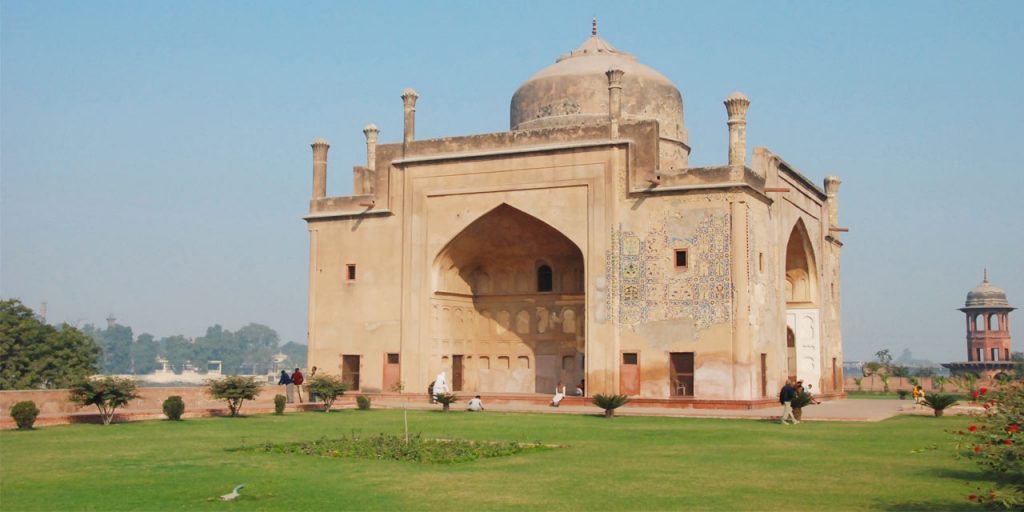
This place is a mausoleum of Shah Jahan’s Prime Minister and Persian poet Afzal Khan Mullah. It is situated just one km away from Itmad-ud-Daula Tomb. The monument is set amid well-tendered gardens, known for its blue glazed tile. The glazed tiles used in the monument are made from porcelain which is also known as “Chini Mitti” or “Chinese Clay” which is said to be brought from China. The tiles used in the monument can still be seen on a small part of the exterior while most of the interior is painted in Floral Designs. This place is a curtain raiser to an exotic Persian art style, which finds itself a home in Agra. You can visit the place from sunrise to sunset any day.
Mariam’s Tomb
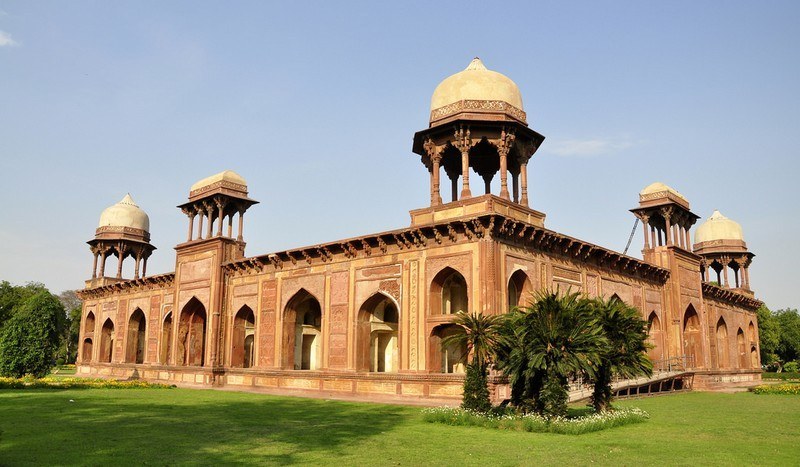
This unique tomb in red sandstone was built in the memory of Emperor Akbar’s wife Mariam Zamani. The tomb is just a km away from the tomb of Akbar. It is situated on the Delhi-Agra National Highway, near Fatehpur Sikri. Born a Rajput Princess, Heer Kunwari was married to Akbar in 1562, and rechristened as Mariam-uz-Zamani. She bore Akbar a son, the future king, Jahangir. After her death in 1623, Jahangir built a tomb for her close to Sikandra. The tomb has exceptional carvings and the ground floor consists of some forty chambers built by Sikandar Lodi, which bear faint traces of paintings on plastered walls. The centre of the ground floor houses the cenotaph of Mariam. The facades of the baradari had been covered with red sandstone, which is cut into numerous panels and adorned with geometrical patterns carved in bas-relief. Each quoin of the structure is added with an ornamental octagonal tower. The tower is crowned by a pavilion supported by slender pillars. The upper storey contains the marble cenotaph, which is open to sky.
Ram Bagh
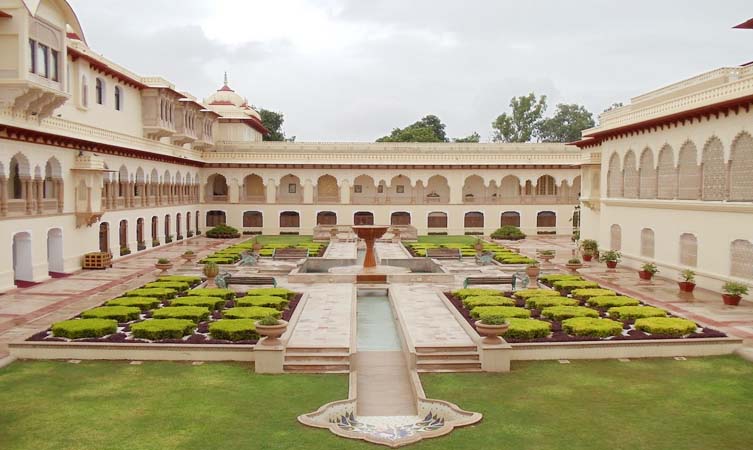
Ram Bagh is one of the earliest Mughal gardens, believed to be laid out by Mughal Emperor Babur, the founder of Mughal Dynasty. The Garden is located just 3 KMs away from the Tomb of Itmad-Ud_Daula and 500 meters away from the Chini ka Rauza. It is Agra’s oldest garden which was established in 1528, and is an oasis in the thick of a bustling market. It is said that Babur was temporarily buried here before being taken to Kabul in Afghanistan. It was established by Babur and was later renovated by Noor Jahan, wife of Jahangir.
Nagina Masjid
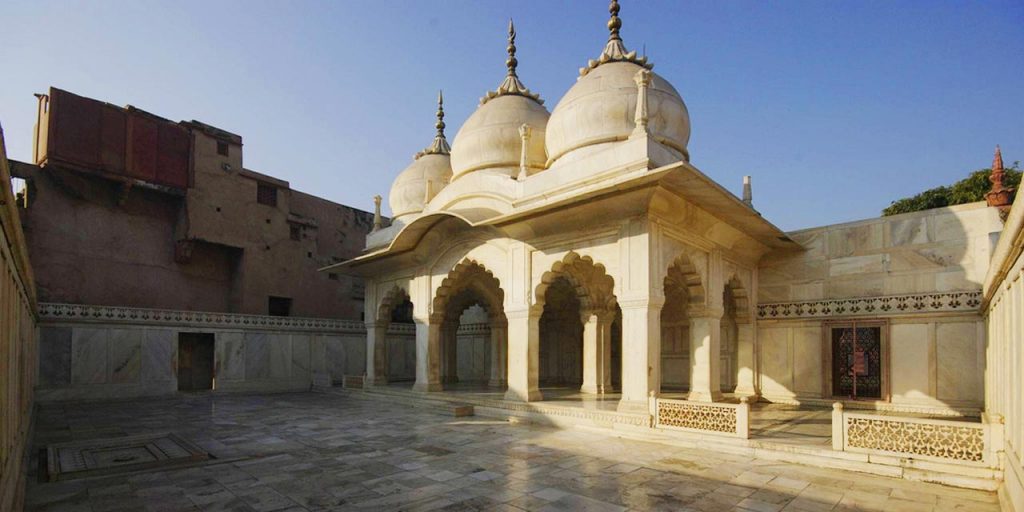
Nagina Masjid is a beautiful mosque located in Agra Fort. It is located near Moti Masjid. This mosque is constructed with pure white marble and hasabeautifully designed prayer chamber. The Mosque built in the north-western corner of the Machchi Bhawan was meant for the personal use of the Emperor. It has a marble paved court enclosed by walls to the north, south and east and the prayer chamber on the west. The prayer chamber is also made up of marble and has three domes on its top. The mosque has a three-arched façade with the cusps and supported on slender piers as its entrance. The arch in the middle is larger and has nine cusps and ones on the either sides have seven cusps only.
Mehtab Bagh

Mehtab Bagh is located on the left Bank of River Yamuna opposite to the Taj Mahal. This park is originally built by Emperor Babur as the last series of the 11 parks on the Yamuna’s bank.The garden complex, square in shape, measures about 300 by 300 metres (980 ft × 980 ft) and is perfectly aligned with the Taj Mahal on the opposite bank.The excavation has revealed a huge octagonal tank at center and a gateway at the northern wall.This is now one of the best places to view the great mausoleum.
Jama Masjid
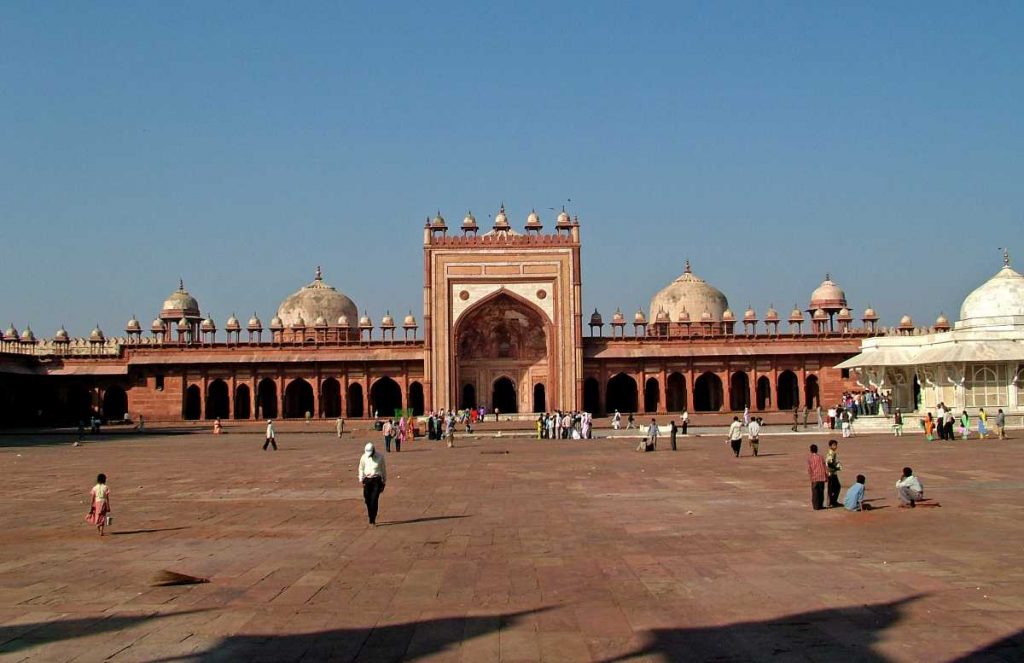
The Jama Masjid is one of the Largest Mosque built by the Mughals in India. This Masjid houses a rectangular open forecourt constructed in 1648 A.D by Shah Jahan's daughter, Jahanara Begum. The architecture of this monument is done beautifully while imbibing the Iranian architecture and is built using red sandstone and white marble .The construction of Jama Masjid required some 5,000 workers and was completed in a time period of 6 years.
Guru Ka Taal
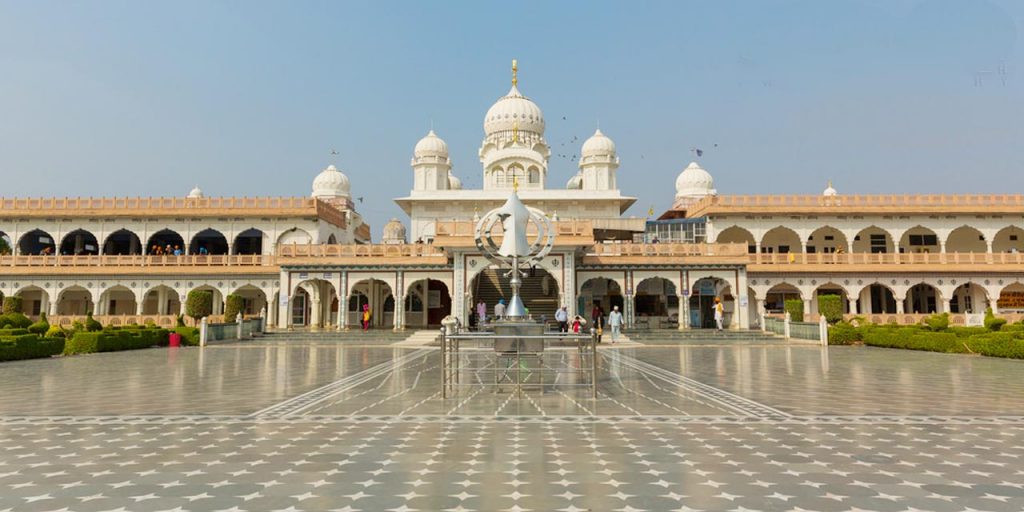
Guru Ka Taal is a very famous Gurudwara in Agra. The construction of this place was started in the 1970’s and it is said that the four out of the 10 Sikh gurus are said to have paid it visit. This Gurudwara has both historical and religious importance, and attracts large number of devotees and tourists. Every year thousands of devotees gather here to pay homage to the great Sikh guru. This beautiful structure is reckoned among the magnificent architectural wonders of India. Boasting elaborate stone carvings this Gurudwara beckons travellers from far and away to bask in its glory.
Food in Agra
Petha
Agra is famous for its Petha. It is a sweet made from white pumpkin or ash gourd and is infused with different flavors. This delicious sweet is found in many different varieties and shapes. The twopopular varieties of Petha are - the dry, hard and chewy ones and the other is soft and syrupy. The Petha is available in many variants like plain (white), Kesar(saffron),Angoori Petha and Paan Petha to name a few. Petha is believed to have medicinal traits and is considered beneficial for blood pressure, hydration, brain growth, and more. The best place to buy Petha in Agra is Panchi Petha located at Hari Parvat Crossing.
Dalmoth
Dalmoth is a mixture of nuts, spices, lentils and oil. It is a traditional Namkeen crispy, spicy, and a little bit greasy. The best Dalmoth can be found in Panchi Petha and Baluganj .This tastes best with a cup of tea when you wish to munch something crunchy.The Dalmoth is packaged in boxes and bags, this traditional namkeen (snack) will overwhelm your taste buds with a spicy flavor.
Bedhai & Jalebi
Bedhai is a typical breakfast, usually served at street stands in Agra. This is a sweet and spicy combination which consists of two parts: spicy bedhai and sweet Jalebi. Bedai is a fried, puffy bread,which resembles Kachori and is served with a bowl of spicy sabzi dotted with hunks of potato and a dollop of curd.The jalebi, is a luscious dessert which is made out of fermented batter which is fried and then soaked in hot sugary syrup. This is a balanced breakfast and can be found in every corner of the city. The Famous point where one can find delicious Bedhai and Jalebi are GMB and Shree ji sweets on Fatehabad road.
Paratha
Paratha is a famous dish of the Mughlai Cuisine and Agra is famous for it. Parathas in Agra are mostly vegetarian, made with pan fried flat wheat bread which is stuffed with potatoes, cauliflower, carrots and cheese. Parathas will satisfy your craving for traditional Indian flavors. People usually eat them in breakfast accompanied with curd, pickle and chutney and it is said to be a wholesome and nourishing Indian Breakfast. When in Agra Rambabu parathe wale on old Delhi Agra highway are the famous Paratha points serving mouth-watering parathas.
Mughlai Food
The Mughlai Food is a souvenir of the Mughal era in India.The food has been borrowed from the Mughal kitchen.The Mughlai dish mainly consists of meat enriched with creamy, boldly flavoured curries; with lots of dried fruits with ground as well as whole spices. As time passed, the Mughlai dishes travelled from Agra to different parts of North India. However, the taste of Mughlai food in Agra is special and delicious. When the Mughals made Agra the Capital city of India in the 16th century, they left indelible imprints on the cuisine of Agra. The best places to get the lip smacking and original taste of the Mughlai food in Agra are areas like Nai ki Mandi area on MG road, Indiana, Pinch of Spice, Taj Mahal Restaurants on Fatehabad road
Chaat
Chaat is very popular in Agra as a part of snacks, especially Dahi-bhalla, Raj kachori, samosas, and gol gappas. While talking about Agra we shall only focus on the Bhallas as it is city’s favourite. The bhalla in Agra is a fried potato and chickpea patty that’s smashed open and topped with grated ginger and a spicy-sweet tamarind sauce. The Bhallas here are made bigger and crispier than the others. This is a perfectly satisfying snack that can only be found on the streets of Agra. To enjoy the true taste of the chaat in Agra one can explorechaat wali gali in sadar bazar.
Festivals
Taj Mahotsav
Taj Mahotsav is the most famous festival in Agra organized in the month of February for a period of 10 days. The festival organized by Uttar Pradesh Tourism is aimed to promote the creative art craftsmen and help them showcase their respective skills. Arts, crafts, cultures, different kinds of food and traditions of the country are at display here. Various traditional performances by local artists also take place at the Taj Mahotsav. Also, there are camels and elephant rides which attract the kids. The festival is celebrated to welcome spring with pomp and show. It begins with a huge procession with decorated camels and elephants and following them are folk artists who display their respective arts. Chikankars from Lucknow, Handmade Carpet makers from Bhadohi, Wood Carvers from Saharanpur all come here to display their excellent work. Beyond these other major attractions include - famous pottery from Khurja, beautiful silk sarees from Varanasi, Sapera dance form of Rajasthan, famed Nautanki of Uttar Pradesh and Lavani dance of Maharashtra and many more.
Bateshwar Fair
Bateshwar is a small town located 70 km away from Agra. The name of the town comes from the deity called Bateshwar Mahadev. Bateshwar is culturally and spiritually significant because of its 108 temples belonging to many different goddesses and gods of Hindu religion. An annual fair is organized here during the months of October and November. This festival is celebrated in honour of Lord Shiva and lasts for a month. Lord Shiva’s devotees come here to take dip in the holy Yamuna. A cattle and livestock fair is also arranged at the celebrations. The festivities extend all the way to Agra.
Ram Baraat
Ram Baraat is organized annually before the festival of Dussehra. It is celebrated as ‘barat’ or marriage procession of Lord Rama. The festival is actually a part of the re-enactment of Ramleela which finishes into the celebrations of Dussehra with the execution of effigy of Ravana by Lord Rama. ‘Janakpuri’ the palace of Sita is setup at a venue where the ‘baraat’ arrives. The procession highlight is the colorful and decorated ‘Jhankis’ that are carried. The venue is where the fair takes places and people of faith flock here to witness the wedding. The idols of Lord Rama and his brothers are decorated with jewels and are placed on a chariot which is a part of the procession.
Kailash Fair
On the outskirts of Agra, a Kailash fair is organized at Kailash temple to honour Lord Shiva. Organized in the month of August or September, it marks the auspicious sighting of Lord Shiva as the ‘Lingam’. Devotees from Agra and nearby areas come to attend this fair.
Things to do in Agra
Taj Mahal at Sunrise and Sunset
The best view of the Taj Mahal is during sunrise. There are fewer crowds, the air is cool and pleasant. Sunset is another time to enjoy the white marble masterpiece.
Taj Mahal for five nights during full moon
It is said that during the full moon the light from the moon illuminates the Taj Mahal not seen on a regular light. It is a sight to behold for one and all. It is available to seen for five days around new moons. The tickets can only be bought a day in advance and entries are also limited.
Taj Nature Walk
Many different locations in the city offer great and artistic views of the Taj Mahal. One such spot is 500m away located on the East gate road of Taj. It is a maintained lush 180 acre garden that has 20 ft high watch towers for perfect views of the white marble magnificence. It is advisable to visit during sunrise and sunset to get splendid views.
Nearby Excursions
Fatehpur Sikri
Perched atop a rocky ridge, 37 KM west of Agra, Fatehpur Sikri came into being centuries ago as a city of victory for Emperor Akbar. The city’s red sandstone architecture and intricate carvings give a dreamy experience.
Mathura
Located at a distance of 49 KM from Agra, Mathura is the birthplace of Lord Krishna. Dotted with magnificent temples depicting the various phases of Lord Krishna’s life it takes the devotees back to the divine era.
Bateshwar
Bateshwar, an ancient temple complex and an important spiritual and cultural centre for Hindus, is located at a distance of 70 Km from the city of Taj , Agra. The place is named after the presiding deity of the region BATESHWAR MAHADEV (another name of Lord Shiva). The temple complex consists of more than 100 temples dedicated to lord Shiva. The temples are all lined along the crescent shaped curve of the river-front and several have ghats (steps) leading down to the water. Said to be the birthplace of Lord Krishna’s mother, Bateshwar is associated with numerous myths and legends. Several ancient scriptures refer to it as Surajpur in honour of its founder Raja Suraj Sen, Lord Krishna’s grandfather.
Chambal Sanctuary
Chambal Sanctuary Sanctuary (just 10 Km from Bateshwar) an opportunity to explore the natural, cultural and historical heritage of the Chambal Valley. More then 600 Sq kilometers stretch of the river was designated as the National Chambal Sanctuary and given protected areas status. The sanctuary currently boasts of 242 species of resident and migratory bird species, Marsh crocodiles (muggers), gharial (gavials), eight species of turtles, and Gangetic dolphins.
Keetham Bird Sanctuary
Keetham Bird Sanctuary - Sur Sarovar Bird Sanctuary, also known as Keetham Lake, was established in 1991 by the Uttar Pradesh Forest Department. It is home to more than 165 species of resident birds & migratory birds. The sanctuary also has the population of more than 300 of pythons. It is also one of the biggest bear resue centre of India for dancing bear.
It is a small, but important bird sanctuary of Uttar Pradesh. It comprises of fresh water wetland, popularly known as Keetham jheel. Seeing the large number of migratory as well as resident birds arriving in this wetland year – after- Year, the area was declared a Sanctuary in 1991.
Unique for scenic beauty, religion-cultural heritage and rich assembling of fauna and flora, It has been named after Soordas – the great poet of Hindi literature, who was born blind and whose place of birth is said to be within the boundary of this sanctuary.
A huge lake surrounding by dense and luxuriant vegetation is a rare experience and picturesque sight in the semi-arid part of the country. Situated close to the important city of Agra, this sanctuary, though small in size is very rich in avifauna. It is an important birding destination for ornithologists.
Agra's Tourist Map
